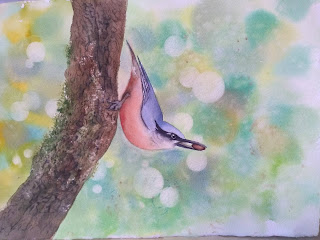ROCKS AND WATER-a stream in Gatlinburg, TN
Saturday, February 25, 2023
Rocks and Water--a stream bed
Friday, February 17, 2023
Texture methods for painting rocks
INDIVIDUAL ROCKS
In order to show different methods of creating rock, I first drew a cairn (stack of rocks used in national parks, Iceland, and other parts of the world to navigate trails in the wilderness). I made it similar to one of these (photo from unsplash, by Daniel Tellez Cabrere).
There are two or three important things to remember when painting rocks, or any object outdoors. The first is to establish your source of light, and keep it consistent throughout the painting. In this one, I chose to have the light coming from the top left. (See the pretty sun?) That means that surfaces that the light hits directly will be the lightest; areas where no light gets in are the very darkest (like the underside of the rocks). Other areas that do not receive direct sunlight are a medium value.
The second is that you need at least three values --light, medium, dark--to depict a 3D object. There are a lot of other things you can learn about light--reflected light, cast shadows, etc.--but for now, your rocks will be believable if you make sure that you have those 3 distinct values.
Miscellaneous tools used in this exercise were: salt, cut credit card, wax (from candle, crayon, or paraffin), wax paper, alcohol, sponge, and fan brush (or hog bristle brush). Colors used were mostly cobalt (or ultramarine) blue, burnt sienna, ochre, and burnt umber. Keeping it simple.
For the first rock, I just gently rubbed a stick of paraffin onto the rock surface. Then I painted a medium wash of burnt sienna and cobalt over it. When it dried, I darkened the shadow area by adding some burnt umber.
The second rock you see below was the same burnt sienna/cobalt mix with a little ochre to warm it a bit. While shiny, I added some table salt and scratched into areas with the point of a cut credit card. (Other tools can be used to do that) After it dried, I darkened the shadow underneath. Last, I sponged some green over the top left to look like moss.
Friday, February 3, 2023
Making a Bokeh Painting - Bird Part 1
SECRETS TO CREATING A BOKEH EFFECT
Bokeh is a photography term used to describe a soft, out-of-focus background. There are often round circles of sunlight in it.
I've tried several different techniques for creating bokeh in watercolor, and have been mostly successful. After watching a Karen Rice method of doing it, I decided to add that to my repertoire, with a few changes.
The two main things I learned were:
A. Use only lifting colors (I'll list some of them below)
B. Apply background colors in circles, wet into wet.
Step One: Wet the background (shiny, not puddly), and start applying color in circular shapes.


































